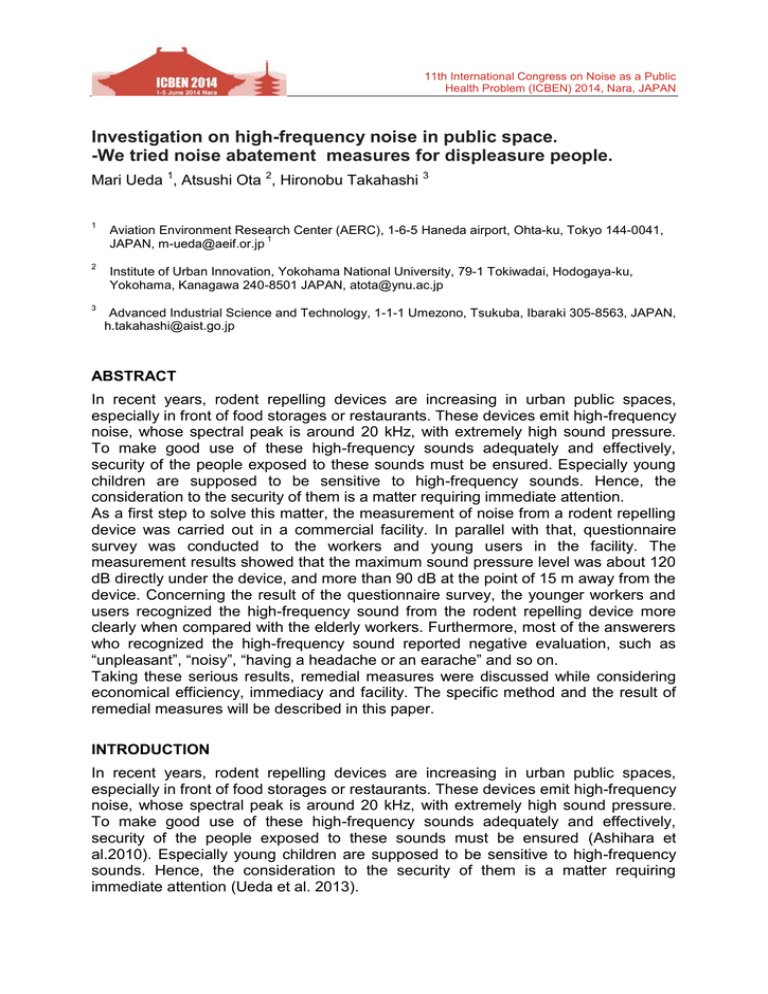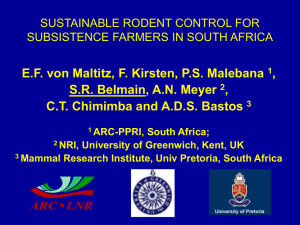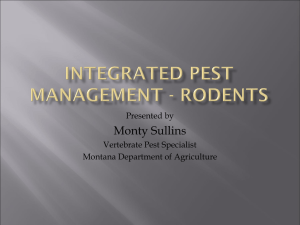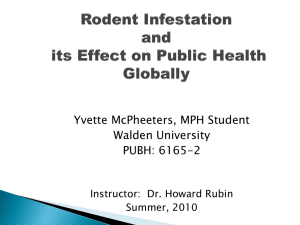
11th International Congress on Noise as a Public
Health Problem (ICBEN) 2014, Nara, JAPAN
Investigation on high-frequency noise in public space.
-We tried noise abatement measures for displeasure people.
Mari Ueda 1, Atsushi Ota 2, Hironobu Takahashi 3
1
Aviation Environment Research Center (AERC), 1-6-5 Haneda airport, Ohta-ku, Tokyo 144-0041,
1
JAPAN, m-ueda@aeif.or.jp
2
Institute of Urban Innovation, Yokohama National University, 79-1 Tokiwadai, Hodogaya-ku,
Yokohama, Kanagawa 240-8501 JAPAN, atota@ynu.ac.jp
3
Advanced Industrial Science and Technology, 1-1-1 Umezono, Tsukuba, Ibaraki 305-8563, JAPAN,
h.takahashi@aist.go.jp
ABSTRACT
In recent years, rodent repelling devices are increasing in urban public spaces,
especially in front of food storages or restaurants. These devices emit high-frequency
noise, whose spectral peak is around 20 kHz, with extremely high sound pressure.
To make good use of these high-frequency sounds adequately and effectively,
security of the people exposed to these sounds must be ensured. Especially young
children are supposed to be sensitive to high-frequency sounds. Hence, the
consideration to the security of them is a matter requiring immediate attention.
As a first step to solve this matter, the measurement of noise from a rodent repelling
device was carried out in a commercial facility. In parallel with that, questionnaire
survey was conducted to the workers and young users in the facility. The
measurement results showed that the maximum sound pressure level was about 120
dB directly under the device, and more than 90 dB at the point of 15 m away from the
device. Concerning the result of the questionnaire survey, the younger workers and
users recognized the high-frequency sound from the rodent repelling device more
clearly when compared with the elderly workers. Furthermore, most of the answerers
who recognized the high-frequency sound reported negative evaluation, such as
“unpleasant”, “noisy”, “having a headache or an earache” and so on.
Taking these serious results, remedial measures were discussed while considering
economical efficiency, immediacy and facility. The specific method and the result of
remedial measures will be described in this paper.
INTRODUCTION
In recent years, rodent repelling devices are increasing in urban public spaces,
especially in front of food storages or restaurants. These devices emit high-frequency
noise, whose spectral peak is around 20 kHz, with extremely high sound pressure.
To make good use of these high-frequency sounds adequately and effectively,
security of the people exposed to these sounds must be ensured (Ashihara et
al.2010). Especially young children are supposed to be sensitive to high-frequency
sounds. Hence, the consideration to the security of them is a matter requiring
immediate attention (Ueda et al. 2013).
11th International Congress on Noise as a Public
Health Problem (ICBEN) 2014, Nara, JAPAN
In this work as a first step to solve this matter, the measurement of noise from a
rodent repelling device was carried out in a commercial facility. In parallel with that,
questionnaire survey was conducted to the workers and young users in the facility.
In addition, taking these serious results, remedial measures were discussed while
considering economical efficiency, immediacy and facility. The specific method and
the result of remedial measures will be described in this research.
ACOUSTIC MEASUREMENT OF A FIELD STUDY
Measurement overview
To understand the actual exposure to rodent repellents, we conducted acoustic
measurement in a public area in the Tokyo Metropolis. Figure1 shows the
measurement points in the measurement area (83 points). Figure 1-(a) presents the
measurement points for the sound-pressure distribution of a single rodent repellent.
Figure 1-(b) presents the measurement points (22 points) to understand the soundpressure distribution in the whole passage where multiple rodent repellents are
installed.
All measurements were made 1,500 mm above the ground with a WS3 microphone
(B&K, Type4939), and the results were recorded on a data recorder (NF, EZ7510)
via a microphone adapter (B&K, UA0035), pre-amplifier (B&K, Type 2673), and
conditioning amplifier (B&K, Type2690). Sixteen-bit quantization was performed, the
sampling frequency was 200 kHz, and the measurement was recorded for 5 sec at
each measurement point.
Figure 1: Plan and elevation of measurement area:
(a) Single rodent repellent. (b) Multiple rodent repellent.
11th International Congress on Noise as a Public
Health Problem (ICBEN) 2014, Nara, JAPAN
Measurement results
Figure 2 shows the FFT analysis results (20,000 points) of the sounds recorded
under a single rodent repellent (Figure 1-(a): Below the sound source). In the
spectrum, there is a peak of about 100 dB (SPL) between 19 and 20 kHz. A
remarkable component over 80 dB (SPL) was confirmed around 38 kHz. Therefore,
we calculated the sound pressure distribution over the whole measurement area
(Figure 1: Plan) of 19 ±3 kHz, which is the most remarkable frequency component
(Figure 3). In the figure, the x axis corresponds to the opposite side of the rodent
repellent, and the datum corresponds to the point just under the sound source. The
sound pressure was around 130 dB just under the sound source and attenuated with
distances in the lateral and back-and-forth directions, but it was still 90 dB or more 14
m in the x-axis direction from the sound source. A single rodent repellent thus
generated a high sound-pressure level over a considerably wide area.
Figure 4 shows the sound pressure level at 19 ±3 kHz at each measurement point in
the central part of the passage (a section of 0 to 63 m) when multiple rodent
repellents are installed. The sound pressure level was confirmed to exceed 100 dB
over a wide range even in the central part of the passage, although there are up to
10 dB differences between individual measurement points.
Figure 2: Frequency characteristics of sounds from the rodent repellent are shown. The sound of the
rodent repellent was recorded at a certain restaurant district in Tokyo Japan.
Figure 3: Sound pressure distribution by the rodent repellent is shown. The measurement was made
at the measurement area (Fig.1 (a): Plan).
11th International Congress on Noise as a Public
Health Problem (ICBEN) 2014, Nara, JAPAN
Figure 4: Sound pressure distribution of sounds emitted by the rodent repellent is shown. The
measurement was made at the measurement area (Figure 1 (b): Plan).
QUESTIONNAIRE SURVEY
We conducted a survey to clarify the influence of high-frequency sounds generated
by the rodent repellent (Figure 1).
Survey overview
A total of 35 participants answered the questionnaire, including 29 college students
(17 male and 12 female) and six additional subjects in their late 20s to 50s. In the
survey, participants were informed where the rodent repellents were installed
(Figure1) and how to listen for them. Each subject then answered the questions after
hearing the sound generated. Participants were first asked if they had heard the
sound generated, and only those who responded “Yes” were asked the subsequent
questions. A total 35 of questions were asked about the contents including the age,
sex, impression of the sound generated (selecting from among 26 adjectives,
including discomfort rated on a 5 scale), and degree of awareness of the sound
source. The survey was conducted in 2012.
Survey results
Thirty-one subjects (89%) answered that the sound could be heard clearly, and four
(11%) answered that the sound can be heard. Figure 5 shows the evaluation results
of the impression of the sound generated (the scores were averaged among 35
responders for each adjective). The discomfort score was 4.0, indicating that many
responders felt the sound generated was uncomfortable. The score of “noisy” was
also high. For physiological influences, the scores of “pain in the ear” and
“restlessness” were high, while the scores of “nausea and dizziness” were relatively
low.
For the degree of the sound source awareness, 43% of the subjects answered that
they “know (the device).” However, when asked about the kind of sound, many of
them mistook it for a “mosquito sound.” In addition, some responded that “my head
may split” and “I will never come here again because of the pain in the ear.”
11th International Congress on Noise as a Public
Health Problem (ICBEN) 2014, Nara, JAPAN
Figure 5: The evaluation results of the impression of high-frequency sounds generated by the rodent repellent. A radar chart shows the average value of each adjective.
NOISE ABATEMENT MEASURES FOR DISPLEASURE PEOPLE
Overview
We examined countermeasures for children and youths who felt discomfort from the
sounds generated by the rodent repellent. In cooperation with the building managers
and the rodent repellent installers, we decided to relocate the rodent repellents.
Figure 6 shows the countermeasure area and the measurement points after the
relocation of rodent repellents. The rodent repellents were relocated from the
passage to the backyard on the opposite side of the door.
A total of 36 measurement points were selected; the measurement instrument and
method were the same as those used in Figure1 of this report.
Figure 6: Plan and elevation of measurement area and measurement points (36 points).
11th International Congress on Noise as a Public
Health Problem (ICBEN) 2014, Nara, JAPAN
Results
Figure 7 shows the FFT analysis (20,000 points) results (Figure 7)of the sounds
recorded just under the sound source before the relocation and the sound-pressure
levels over the whole measurement area before and after the relocation. A peak of
100 dB (SPL) or more was confirmed near 19 kHz before the relocation, but that
peak was reduced by about 20 dB after the relocation. The third and fourth
harmonics that had been remarkable before the relocation were reduced and
became buried in the noise. The sound-pressure distribution was obtained at each
frequency within the range of 19 ±3 kHz. The difference in sound-pressure levels at
the datum across the relocation was 21.7 dB, and the sound-pressure level was
reduced by 20 dB after the relocation to the opposite side of the door at all
measurement points. The 10 subjects aged 30 to 40 who were able to hear the
rodent repellent in the present state could not hear the same sound after the
relocation near the sound source and in the passage.
Figure 7: Frequency characteristics and sound pressure distribution by the rodent repellent are shown.
11th International Congress on Noise as a Public
Health Problem (ICBEN) 2014, Nara, JAPAN
CONCLUSIONS
In this study, we conducted measurements and a questionnaire concerning rodent
repellents that use high-frequency sounds to basically examine utilizing highfrequency sounds appropriately and safely in public spaces. Based on the results, we
tried to apply countermeasures for those who felt discomfort from the sounds. We
found that the rodent repellent measured at this time has a peak near 19 kHz and a
sound pressure of 120 dB(SPL) or more. The sound-pressure level was 90 dB or
more even 14 m from the sound source, so the rodent repellent generated a high
sound pressure over a wide area. When multiple rodent repellents are installed in
the whole passage, the sound-pressure level exceeded 100 dB at all measurement
points in the central portion of the passage. The questionnaire revealed that all
responders aged 20 to 50 can hear the sound generated and that more than half of
them felt discomfort from such sound.
We tried relocating the devices to reduce the discomfort from the sound generated.
Relocation reduced the sound-pressure level by 12 dB or more. After the relocation,
all adults aged 30 to 40 responded that they could not hear the sound. However, the
sound-pressure level in the measurement area is 100 dB or more even after
relocation, so such a countermeasure may be inadequate if its influences on children
and youths are considered.
In the future, we will investigate the psychological and physiological influences of the
sound generated on children and youths and then examine the feasibility of a more
effective countermeasure. Furthermore, there is no quantitative measurement
technique for evaluating the sound reduction in the high-frequency band, so we will
examine a quantitative measurement method for evaluating the sound reduction in
the high-frequency band, which has received little attention so far, based on the
needs at this time.
REFERENCES
Ashihara, K. (2009). J. Acoust. Soc. Am. 122, EL52-EL57, 2007.
Ueda, M. et al., (2013). Sound in Science Education “Measurement of hearing threshold for very-high-frequency tone of
children. –How high-frequency do children hear?-”. 2012 Spring meeting, Acoustical society of Japan, pp: 575-578. (in
Japanese)










